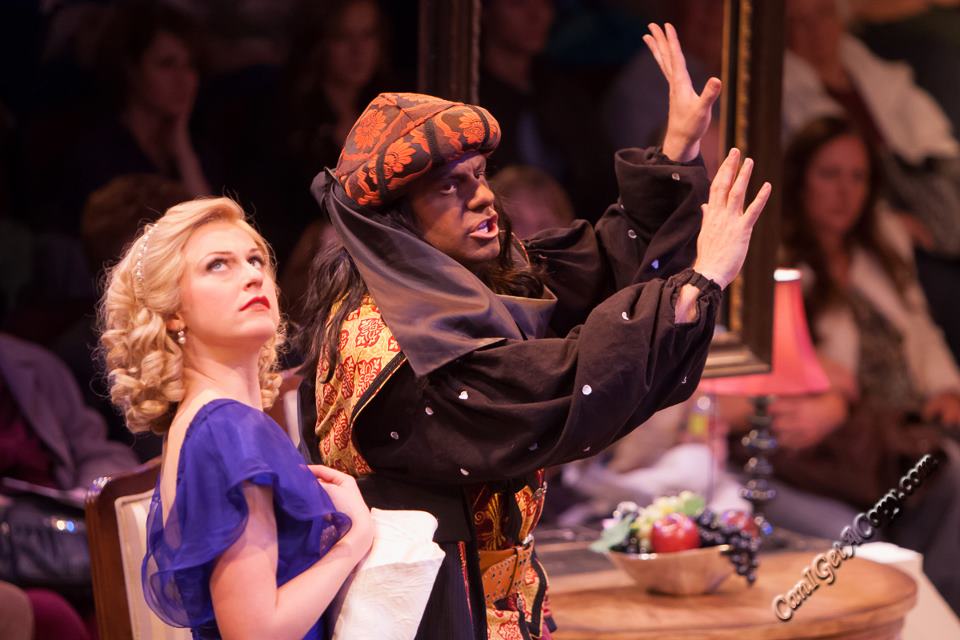OREM — I love a good farce. With mistaken identities, slamming doors, running back and forth, and just a dash of innuendo, Ken Ludwig’s Lend Me a Tenor is a solid example of the genre. The current production at the Hale Center Theater Orem, directed by Kymberly Mellen, succeeded in some respects, but overall leaving something to be desired.

The basic plot is rather simple, and yet finds ways to take all sorts of twists and turns. The Cleveland Opera has managed to book the famous Tito Merelli, a revered tenor. When he shows up to his hotel room, he is greeted by a number of people eager to wait on him hand and foot. When complications arise just before the performance, the opera’s manager, Henry Saunders, makes his awkward assistant, Max, step in and do the role without telling anyone about the switch. This means that Max must dress as Tito would have, including the use of blackface, which makes him almost unrecognizable to everyone. This switch leads to all sorts of confusion as different lovers, cast members, producers, etc., have interactions with the wrong man.
The thing that will make or break a farce is the timing. This includes both the co-ordination of events (people entering and exiting at just the right moment) as well as the basic comedic timing (knowing when to say the punch line, or give the right look). The Hale’s production was a toss-up for me. The first act felt disjointed, almost as if the actors weren’t quite listening to each other, or at times like lines were being left out or made up. While it didn’t absolutely ruin the performance, there were a number of moments in which the comedy really suffered because of the choppiness. By the second act, however, things really seemed to start gelling together and the comedy came more naturally. The finale of the show was just like a farce should be, with all of the elements working seamlessly together to create some epic mayhem for a hilarious climax.

The acting in the show suffered the same aforementioned shift from choppy to polished. In the first act it felt like I was watching talented people, good performers, but ones who were not focused or listening. On the whole, the cast was quite skilled. They were audible and had good diction. They had made character choices. And yet, it seemed to lack heart and felt kind of like going through the motions. Again, this was noticeable, but it didn’t make the utterly unbearable. Then in the second act things clicked, and the characters became believable, the comedy became hilarious, and the show reached the potential that one could feel in the first act.
The most consistent performer, and one of the funniest, was Chase Ramsey, who played the Bellhop. Ramsey was always a treat to watch on stage and had the perfect timing to steal whatever scene he was in. And yet, he never went so far as to take the focus from where it needed to be. Ramsey’s timing was perfect, he had great facial expressions, and his reactions were priceless. Another performance that stood out was that of Marshall Lamm, playing the stupendous Tito Merelli. The challenge for Lamm was getting the humor across through an Italian accent, which he did quite well. The accent wasn’t perfect and the timing wasn’t always there, but in the end, the character of Merelli was one of the best in the show.
Blake Barlow, who played the bumbling Max, excelled at making the assistant’s transformation believable. He started as a whiny Rick Moranis type, but was able to believably make the transformation into a confident Rico Suave type. The comedy wasn’t always there for Barlow, but by the end there was a distinct change in his character and a well-developed relationship with his tenor-idolizing girlfriend, Maggie (Brighton Quinn Hertford).
I was less impressed with the performance of E. Scott Wells as the producer, Henry Saunders (who also happens to be Maggie’s father and Max’s Boss). Wells had the tendency to rush through lines, which made them incoherent at times. This was particularly frustrating when Henry Saunders had quite a few lines in which important plot points were revealed.
The scenic and costume designs (Bobby Swenson and Maryann Hill, respectively) were impressive. I loved the creativity in the set. Swenson had a difficult theater-in-the-round space to deal with in which to create multiple rooms and all those slamming doors. The use of half-doors and raising certain parts of the bedroom dealt with the threat of blocked sightlines. The costumes were well constructed and helped to define the characters. The costumes were especially effective with the gag of Max and Tito matching and consistently being confused with each other.
In the end, this is not a bad show. There were plenty of great moments, especially in the second act. The comedic timing and acting in the first act may improve as the run of the production progresses. The show is definitely worth a look. I enjoyed myself. I was laughing; just not as much as the script had potential for.
[box type=”shadow”]Lend Me a Tenor shows every night (except Sundays) at 7:30 PM and Saturdays at 3 PM through Feb. 16 at the Hale Center Theater (225 West 400 North, Orem). Tickets are $12-20. For more information, visit haletheater.org.[/box]

